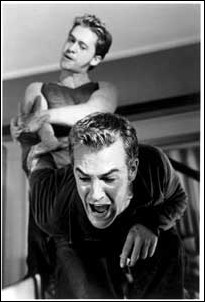‘Attraction’ leaves audiences unsatisfied

Image: ‘Attraction’ leaves audiences unsatisfied:Photo courtesy of Lions Gate Films:
October 16, 2002
Here’s the rule of attraction: you won’t get what you want, so get used to masturbation. Such is the premise of Roger Avary’s film, “The Rules of Attraction,” adapted from a novel by Bret Easton Ellis.
While it stars James Van Der Beek (“Varsity Blues”), Shannyn Sossamon (“A Knight’s Tale”) and Jessica Biel (TV’s “7th Heaven”), denizens of teensploitation movies, the film is more like a WB show gone terribly wrong.
The film begins with a visually and emotionally stunning introduction to the three main characters at an End of the World Party on New Year’s Eve. Virginal Lauren (Sossamon) flips through a pictorial on venereal disease each party night to discourage promiscuity. Bisexual fatalist Paul (Ian Sommerhalder of “Life as a House”) likes synth pop, and Sean (Van Der Beek) is a drug dealer with a desirous glare who can lie at gunpoint.
They all have objects of affection they vainly hope to attain. Lauren fantasizes about a Victor, whose photo she keeps in a sparkly girlie frame in her room. Paul is in love with the strictly heterosexual Sean and frets over outfits to wear in his presence. Sean lusts after a secret admirer and quite literally gets off on the scented purple notes she leaves.
Van Der Beek gives an impetuous and risky performance. Despite his darkness, it’s hard to divorce his character from the one he plays on “Dawson’s Creek.” While he tries to detail his character with psychotic idiosyncrasies, he comes off as little more than an evil Dawson.
Thematically, the film strikes a poignant chord, but irrelevant vignettes and attempts to “Pulp Fiction”-ize the movie confuse its tone. The film is at once a sad portraiture of desire and a hedonistic portrayal of the libido of drug-addled students who never go to class. You’re never sure if the characters need sympathy or rehab.
Director Avary is best known for his writing work on “Pulp Fiction” and for directing 1994’s “Killing Zoe.” He chose to literally play the opening scenes forward and backward, which, added to some split-screen and rapid editing, enhances the film’s visual atmosphere. A split-screen conversation between Sean and Lauren is appealing, but ends up working against the film with a stink of style over substance. The MTV-esque effects make cool videos, but seldom stunning features.
In the hip post-modern movie convention, the story begins where it ends at the New Year’s party, which only produces nostalgia for the film’s potential at the beginning.
The opening sequence gets you all hot and bothered, but the film eventually leaves you unsatisfied.






































































































































